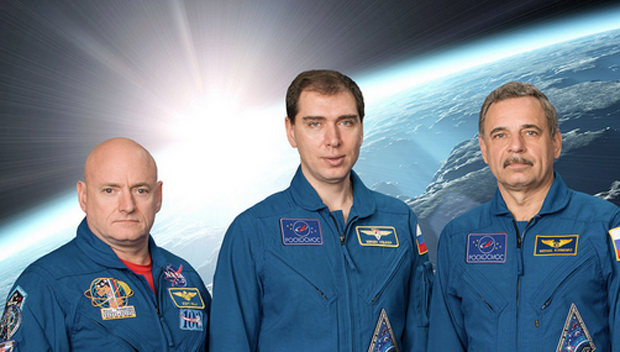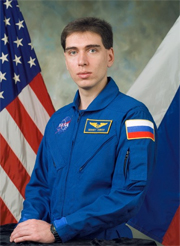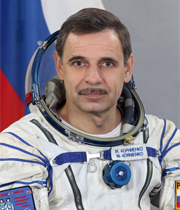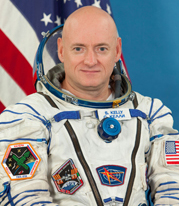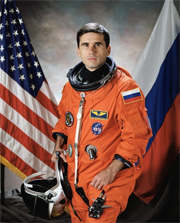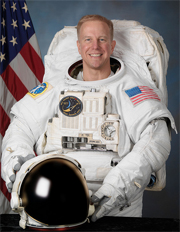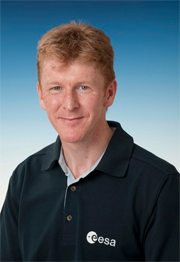Space Station Personnel
The International Space Station relies on three-seat Soyuz spacecraft to ferry astronauts and cosmonauts to and from the lab complex. Once in orbit, crews are members of one or more expeditions, or increments, but their individual Soyuz vehicle/seat assignments typically do not change; they launch and return to Earth (either for a normal end-of-mission landing or an emergency evacuation) aboard the same spacecraft that carried them into orbit.
Soyuz ferry ships are certified for 210 days in space. As such, Soyuz launches are staggered and the station's crew typically drops from six to three when one ferry craft departs and then moves back to six after the next Soyuz in the sequence is launched a few weeks later.
This year, however, a different strategy was employed. Scott Kelly and Mikhail Kornienko were launched in March 2015, along with spacecraft commander Gennady Padalka, aboard the Soyuz TMA-16M spacecraft. Because Kelly and Kornienko are spending nearly a full year aboard the station, Russia had to launch an additional Soyuz to replace TMA-16M.
As such, the Soyuz TMA-18M spacecraft was launched Sept. 2 carrying commander Sergey Volkov, European Space Agency flight engineer Andreas Mogensen and Kazakh cosmonaut Aidyn Aimbetov. Padalka returned to Earth on Sept. 11 (U.S. time) with Mogensen and Aimbetov aboard the TMA-16M spacecraft while Volkov remained in orbit to bring Kelly and Kornienko home in March 2016 aboard the TMA-18M spacecraft.
Crew thumbnails, Soyuz launch/landing dates/mission durations are provided below, followed by detailed crew biographies from NASA, Roscosmos, the European Space Agency and the Japan Aerospace Exploration Agency. Abbreviations: CDR: commander; FE: flight engineer; TIS: time in space; DOB: date of birth. Updates will be posted as warranted. Comments and corrections welcome.
Current International Space Station Crew
SOYUZ TMA-16M/18M CREW BIOS (detailed)
LAUNCH: 03/27/15 (Kelly, Kornienko); 09/02/15 (Volkov)
SOURCE: NASA/Roscosmos
SERGEY VOLKOV
Roscosmos Cosmonaut
PERSONAL DATA: Born April 1, 1973, in Chuguyev, Kharkov Region, Ukraine. Married to Natalia Volkova (Shinkarenko). They have one son, Egor, born in 2001. His hobbies include sport games, tennis, windsurfing, reading, museums
EXPERIENCE: After graduation from the pilot school he served as second commander in the Air Force. He flew L-29, L-39, IL-22, IL-76 and Tu-134 aircraft. Volkov has logged over 500 hours of flight time. He is a Class 3 Air Force pilot and SCUBA diver
SPACEFLIGHT TRAINING: Volkov was selected as a test-cosmonaut candidate of the Gagarin Cosmonaut Training Center Cosmonaut Office in December of 1997. He finished basic space training in November 1999, and was qualified as a test-cosmonaut.
Since January 2000 he completed advanced training with a group of cosmonauts. From September 2001 - February 2003 Volkov completed training as a Soyuz commander and ISS pilot of the ISS 7 backup crew. From April 2004 to February 2005 he trained as ISS-11 prime crewmember for a shuttle launch (STS-121). From January 2005 to February 2006 Volkov was assigned to the ISS cosmonaut pool. From February to April 2006 Volkov trained as an ISS 13/Soyuz 10 visiting crew backup crewmember, and he backed up the space flight participant of that mission.
From May 2006 to April 2008 Volkov trained as an ISS 17 prime crew commander and Soyuz TMA commander. From December 2009 he has been training as a Soyuz TMA-M commander and ISS flight engineer in the ISS-25/26 backup crew.
SPACEFLIGHT EXPERIENCE: Volkov performed his first spaceflight April, 8 - October 24, 2008 as Soyuz TMA-12 commander and ISS commander. During this flight JEM PM of the Kibo module and the JEMRMS manipulator were installed, and ATV-001 "Jules Verne" operations took place for the first time. Volkov logged 12 hours 15 minutes of EVA time in two spacewalks and logged a total of 199 days in space.
SEPTEMBER 2010
MIKHAIL KORNIENKO
Roscosmos Cosmonaut
Soyuz TMA-16M FE (left seat)/ISS-44/45/46 FE
BIRTHPLACE AND DATE: Born 15 April, 1960, in Syzran, Kuibyshev region, Russia.
PERSONAL DATA: Married to Irina Anatolievna Kornienko (Savostina); daughter Natalia.
EDUCATION: Graduated from a secondary school in Chelyabinsk, Russia, in 1977; served in paratroops in 1978 - 1980; in 1981 to 1987 he studied at the Moscow Aviation Institute and graduated with an engineering degree (aircraft engine mechanical engineer).
SPACEFLIGHT TRAINING: In February, 1998 Kornienko was selected as an Energia test cosmonaut candidate, and in 1999, following basic training at the Yu. Gagarin Cosmonaut Training Center, was qualified as a test cosmonaut.
From August 2001 to February 2003 Kornienko was assigned to the ISS 8 backup crew as an ISS flight engineer and Soyuz TM commander (for a launch on the Shuttle). Due to the Columbia tragedy the crew was reassigned.
From March 2003 to August 2005 participated in RS ISS advanced training. From September 2005 to January 2006 participated in ISS advanced training.
From February 2006 trained as ISS 15 bu engineer and Soyuz TMA bu flight engineer.
From March 2007 to August 2008 participated in RS ISS advanced training.
From August 2008 to April 2010 trained as an ISS 23/24 flight engineer and Soyuz TMA flight engineer.
SPACEFLIGHT EXPERIENCE: From April 2, 2010 to September 25, 2010 completed his first spaceflight as a Soyuz TMA-18 and ISS-23 flight engineer with cosmonaut A. Skvortsov and astronaut T. Caldwell-Dyson (NASA). Performed a spacewalk that lasted for 6 hours and 43 minutes. Kornienko has logged 176 days 1 hour and 18 minutes in space.
AWARDS: Golden Star of the Hero of the Russian Federation (April 12, 2011), Gagarin medal, Honorary citizen of Syzran (2010).
DECEMBER 2012
SCOTT J. KELLY (CAPTAIN, USN, RET.)
NASA Astronaut
Soyuz TMA-16M/18M FE (right seat)/ISS-43/44 FE/45 CDR
PERSONAL DATA: Born February 21, 1964 in Orange, New Jersey. He has two children.
EDUCATION: Graduated from Mountain High School, West Orange, New Jersey, in 1982; received a Bachelor of Science degree in Electrical Engineering from the State University of New York Maritime College in 1987 and a Master of Science degree in Aviation Systems from the University of Tennessee, Knoxville, in 1996.
ORGANIZATIONS: Associate Fellow, Society of Experimental Test Pilots; Member, Association of Space Explorers National Aeronautics and Space Administration April 2015
EXPERIENCE: Kelly received his commission from the State University of New York Maritime College in May 1987 and was designated a naval aviator in July 1989 at Naval Air Station (NAS) in Beeville, Texas. He then reported to Fighter Squadron 101 at NAS Oceana, Virginia Beach, Virginia, for initial F-14 Tomcat training. Upon completion of this training, he was assigned to Fighter Squadron 143 and made overseas deployments to the North Atlantic, Mediterranean Sea, Red Sea and Persian Gulf aboard the USS Dwight D. Eisenhower (CVN-69). Kelly was selected to attend the U.S. Naval Test Pilot School in January 1993 and completed training in June 1994. After graduation, he worked as a test pilot at the Strike Aircraft Test Squadron, Naval Air Warfare Center, Aircraft Division, Patuxent River, Maryland, flying the F-14 Tomcat and F/A-18 Hornet. Kelly was the first pilot to fly an F-14 with an experimental digital flight control system installed and performed subsequent high angle of attack and departure testing. He has logged over 8,000 hours in more than 40 different aircraft and spacecraft and has over 250 carrier landings. Kelly holds a United States Coast Guard Third Mate's license. Kelly retired from the U.S. Navy in June of 2012.
NASA EXPERIENCE: Selected by NASA in April 1996, Kelly reported to the Johnson Space Center in August 1996. Following completion of training, he was assigned technical duties in the Astronaut Office Spacecraft Systems/Operations branch. A veteran of three space flights, Kelly has logged more than 180 days in space. He served as pilot on STS-103 in 1999 and was the Mission Commander on STS-118 in 2007. Following STS-103, Kelly served as NASA's Director of Operations in Star City, Russia. He served as a backup crewmember for ISS Expedition 5 and as the Astronaut Office Space Station Branch Chief. Kelly also served as a Flight Engineer for ISS Expedition 25 and as the Commander of ISS Expedition 26. He currently serves as the International Space Station Operations Branch Chief within the Astronaut Office.
Kelly and cosmonaut Mikhail Kornienko have been selected to serve a one-year mission aboard the International Space Station in 2015. The goal of the mission is to understand how the human body reacts and adapts to the harsh environment of space. Data from the expedition will be used to reduce risks to the health of crewmembers as NASA prepares to advance space travel beyond low Earth orbit.
SPACEFLIGHT EXPERIENCE: STS-103 (December 19 to December 27, 1999) was an 8-day mission, during which the crew successfully installed new instruments and upgraded systems on the Hubble Space Telescope (HST). Enhancing HST scientific capabilities required three spacewalks (EVAs). The STS-103 mission was accomplished in 120 Earth orbits, traveling 3.2 million miles in 191 hours and 11 minutes.
STS-118 (August 8 to August 21, 2007) was the 119th space shuttle flight, the 22nd flight to the International Space Station (ISS), and the 20th flight for Endeavour. During the mission, Endeavour's crew successfully added another truss segment, a new gyroscope and an external spare parts platform to the ISS. A new system that enables docked shuttles to draw electrical power from the station to extend visits to the outpost was successfully activated. A total of four EVAs were performed by three crewmembers. Endeavour carried approximately 5,000 pounds of equipment and supplies to the station and returned to Earth with approximately 4,000 pounds of hardware and equipment. Traveling 5.3 million miles in space, the STS-118 mission was completed in 12 days, 17 hours, 55 minutes and 34 seconds.
On October 7, 2010, Kelly launched aboard the Soyuz TMA-M spacecraft to serve a tour of duty on the ISS. He assumed command of Expedition 26 once the Soyuz TMA-19 undocked on November 24, 2010. After a 159 day stay aboard the ISS, Commander Kelly and Russian Flight Engineers Alexander Kaleri and Oleg Skripochka safely landed their Soyuz spacecraft on the Kazakhstan Steppe on March 16, 2011.
On March 27, Kelly, Kornienko and cosmonaut Padalka lauched from the Baikonur Cosmodrome in Kazakhstan to stay aboard the ISS for one year, which is twice as long as typical U.S. missions. This one year mission is critical to understanding how the human body reacts to long duration of spaceflight. The science gathered will be used to determine ways to reduce risks on future deep space missions such as the journey to Mars.
SOYUZ TMA-19M CREW BIOS (detailed)
LAUNCH: 12/15/15
SOURCE: NASA/Roscosmos
YURI IVANOVICH MALENCHENKO
Colonel, Russian Air Force; Cosmonaut instructor
Soyuz TMA-19M commander (center seat)/ISS-46/47 FE
PERSONAL DATA: Born December 22, 1961 in Svetlovodsk, Kirovograd Region, Ukraine.
HONORS: Awarded the Hero of the Russian Federation medal, the National Hero of Kazakhstan medal, Military award of excellence, Meritorious Service medals (3), Commendation medal, Achievement medal, Medal "70 years of the Soviet Armed Forces".
EXPERIENCE: After graduation from the Military Aviation School, he served as a pilot, senior pilot and multi-ship flight lead from 1983 till 1987 in the Odessa Region. In 1987 he was selected as a cosmonaut, and arrived at the Gagarin Cosmonaut Training Center. From December, 1987 to June, 1989 he underwent a course of general space training. After completion of the course, Malenchenko was qualified as a test-cosmonaut. In September, 1989 - December, 1993 he was taking advanced training courses getting ready for spaceflight. In January-July, 1993 Malenchenko trained as commander of the Mir-14 reserve crew. In July, 1993 - January, 1994 he completed training as a backup commander of the Mir-15 crew. In February - June, 1994 he trained for the Mir-16 mission.
SPACE FLIGHT EXPERIENCE: Malenchenko completed his first 126-day spaceflight in July 1 - November 4, 1994 on the Soyuz TM-14 vehicle and the Mir station (Mir-16 mission). The mission included spaceflight of Ulf Merbold, an ESA astronaut as part of the EuroMir program. Malenchenko completed two spacewalks that lasted 11 hours and 7 minutes total. He performed the first manual docking of the Mir station with the Progress M-24 vehicle in the teleoperator mode. Since October, 1998 till September, 2000 Malenchenko trained at NASA for a Shuttle spaceflight (2A, later 2A.2B).
Malenchenko served on the crew of STS-106 preparing the International Space Station for the arrival of the first permanent crew. The five astronauts and two cosmonauts delivered more than 6,600 pounds of supplies and installed batteries, power converters, a toilet and a treadmill on the Space Station. Yuri Malenchenko and Ed Lu performed a 6 hour and 14 minute space walk in order to connect power, data and communications cables to the newly arrived Zvezda Service Module and the Space Station.
Since January, 2001 he trained as a commander of the ISS 7 prime crew. Malenchenko completed his third spaceflight (with NASA astronaut Ed Lu) as an ISS 7 crew and Soyuz TMA commander. The flight lasted from April 26 till October 27, 2003, with a total duration of 185 days.
From November, 2003 until September, 2005 Malenchenko trained with a group of test-cosmonauts.
From October, 2005 until October, 2006 he trained as a flight engineer of the ISS 14 crew and Soyuz commander.
In October, 2006 Malenchenko started training as an Expedition 16 flight engineer and Soyuz commander. The Expedition-16 crew launched on October 10, 2007 aboard a Soyuz TMA-11 spacecraft, docking with the orbiting space station on October 12, 2007. Malenchenko's tour of duty aboard the International Space Station totalled 192 days in space, returning to Earth on April 19, 2008 aboard the Soyuz TMA-11 spacecraft.
APRIL 2008
TIMOTHY L. KOPRA (COLONEL, U. S. ARMY, RET.)
NASA Astronaut
Soyuz TMA-19M flight engineer (left seat)/ISS-46 FE, ISS-47 CDR
PERSONAL DATA: Born on April 9, 1963, in Austin, Texas. Married to the former Dawn Lehman of Lewisburg, Kentucky. They have two children. He enjoys running, swimming, reading, home improvement projects, and spending time with family and friends. His mother, Martha Kopra, resides in Austin, Texas. His father, Dr. Lennart Kopra, is deceased. Dawn's parents, Charles and Betty Lehman, reside in Lewisburg, Kentucky.
States Military Academy, West Point, New York, 1985. Master of Science in Aerospace
Engineering, Georgia Institute of Technology, 1995. Master of Strategic Studies, U.S. Army
War College, 2006. Masters of Business Administration, Columbia University and London Business School, 2013.
ORGANIZATIONS: Society of Experimental Test Pilots; Army Aviation Association of America; American Helicopter Society; United States Military Academy Association of Graduates; West Point Society of Greater Houston; Columbia Business School Alumni Association, London Business School Alumni Club.
SPECIAL HONORS: Empire Test Pilot School Award for the Best Developmental Test Thesis, Class 110, U.S. Navy Test Pilot School (1996); Silver and Bronze Order of Saint Michael, Army Aviation Award (2009, 1999). Awarded the Legion of Merit, Bronze Star Medal, two Meritorious Service Medals, Air Medal, Army Commendation Medal, Army Achievement Medal, NASA Space Flight Medal, NASA Distinguished Service Medal, and various other service awards.
PREVIOUS EXPERIENCE: Kopra received his commission as a second lieutenant from the United States Military Academy in May 1985 and was designated as an Army aviator in August 1986. He then completed a three-year assignment at Fort Campbell, Kentucky, where he served as an aeroscout platoon leader, troop executive officer, and squadron adjutant in the 101st Airborne Division's air cavalry squadron. In 1990, he was assigned to the 3rd Armored Division in Hanau, Germany, and was deployed to Southwest Asia, where he served in Operations Desert Shield and Desert Storm. He completed his tour in Germany as an attack helicopter company commander and an operations officer. After returning to the United States and completing graduate studies at Georgia Tech, he was selected in 1995 to attend the U.S. Naval Test Pilot School. Upon graduation, he was assigned to the U.S. Army Aviation Technical Test Center, where he worked as an experimental test pilot on various projects and served as the developmental test director for the Comanche helicopter program. Other military schools include the Army Parachutist Course, Pathfinder Course, Air Assault Course, the Combined Services Staff School, and the Command and General Staff College. Kopra retired from the U.S. Army in November 2010.
NASA EXPERIENCE: Kopra was assigned to NASA's Johnson Space Center in Houston, Texas in September 1998 as a vehicle integration test engineer. In this position, he primarily served as an engineering liaison for space shuttle launch operations and International Space Station hardware testing. He was actively involved in the contractor tests of the Extravehicular Activity (EVA) interfaces for each of the space station truss segments.
Selected as an astronaut in July 2000, Kopra began his initial training the following month. Kopra completed two years of intensive space shuttle, International Space Station, and T-38 flight training. He then served in the Space Station Branch of the Astronaut Office, where he was involved in the testing of crew interfaces for two space station pressurized modules as well as the implementation of support computers and operational Local Area Network on the station.
After completing a Russian language immersion course in Moscow, Russia, Kopra began training in July 2005 for a long-duration space flight mission. In September 2006, Kopra served with a six-person crew aboard the National Oceanic and Atmospheric Administration's (NOAA) Aquarius underwater laboratory as part of NASA Extreme Environment Mission Operations (NEEMO) 11. During the week-long mission that served as an analog for lunar operations, the crew tested space suit design concepts, communication protocols, construction techniques, and the use of robotic devices. Kopra completed training in Russia, Japan, Germany and Canada at each of the international partner training sites and served as a backup crew member to Expeditions 16 and 17. He then served as prime crew member for Expedition 20. Kopra completed his first space flight in 2009, logging two months in space and completing one spacewalk. Upon his return, Kopra was assigned as a mission specialist for STS-133. After the launch was delayed, Kopra sustained an injury that prevented him from flying. He then served as Chief of the Vehicle Integration Test Office and is now assigned as a flight engineer to Expedition 46 and Commander for Expedition 47.
SPACE FLIGHT EXPERIENCE: On Expedition 20, Kopra served as a flight engineer aboard the International Space Station. He launched with the STS-127 crew aboard the Space Shuttle Endeavour on July 15, 2009 and returned to Earth with the STS-128 crew aboard the Space Shuttle Discovery on September 11, 2009. During the two shuttle missions and tour of duty aboard station, Kopra performed one spacewalk totaling 5 hours and 32 minutes, executed assembly tasks with the space station and Japanese robotic arms, and conducted numerous science experiments.
Kopra launched December 15, 2015 and is currently serving as Flight Engineer for Expedition 46. His next mission will be as Commander on Expedition 47, scheduled to launch in March 2016.
DECEMBER 2015
TIMOTHY PEAKE
European Space Agency Astronaut
Soyuz TMA-19M flight engineer (right seat)/ISS-46/47 FE
PERSONAL DATA: Born in Chichester, England, on 7 April 1972, Tim is married with two sons. Among his leisure activities he enjoys skiing, scuba diving, cross-country running, climbing, and mountaineering in his wife's native Scotland. He has also completed the London Marathon. Other interests include quantum physics and aviation.
EDUCATION: Tim completed his secondary education at Chichester High School for Boys in West Sussex, England, in 1990. In 1992, he graduated from the Royal Military Academy Sandhurst as an officer in the British Army Air Corps. Having been selected for the Empire Test Pilots' School at Boscombe Down, he graduated in 2005 and was awarded the Westland Trophy for the best rotary wing pilot student. He received a Bachelor of Science degree in flight dynamics and evaluation from the University of Portsmouth in 2006.
SPECIAL HONORS: Tim was awarded the Commander-in-Chief's Certificate for Meritorious Service for exemplary and dedicated service to the British Army in 2006.
ORGANIZATIONS: Fellow of the Royal Aeronautical Society; Member of the Society of Experimental Test Pilots.
EXPERIENCE: At school, Tim was a member of the Combined Cadet Force for six years, finishing as Cadet Warrant Officer. Before joining the Army he was part of a six-month Operation Raleigh expedition to Alaska to work on environmental projects.
Upon becoming an Army Air Corps officer in 1992, Tim served on attachment with the Royal Green Jackets as a Platoon Commander in Northern Ireland before beginning flight training. He was awarded his Army Flying Wings in 1994.
Between 1994 and 1998 he served as a reconnaissance pilot and flight commander in Germany, the Former Republic of Yugoslavia, Northern Ireland, Kenya and Canada. He also qualified as a Combat Survival and Rescue Instructor, and a Flight Safety Officer.
Tim qualified as a helicopter flying instructor in 1998 before being selected for an exchange posting with the US Army (1999-2002). On his return to the UK, he became an Apache helicopter instructor from 2002 to 2005, before being selected for test-pilot training.
On completion of test-pilot training, Tim served with Rotary Wing Test Squadron, Boscombe Down, between 2006 and 2009. He was involved in numerous test flights on several different types of military helicopter. He was also the Squadron Training Officer and qualified as a Post Crash Management Incident Officer.
On retirement from the British Army as a major in 2009, Tim was employed as a senior helicopter test pilot for AgustaWestland. During his career, he has logged over 3000 hours' flying time on more than 30 types of helicopter and fixed wing aircraft, including the Hawk, Dakota, Harvard and Mi-17. He maintains his flying as a major in the Territorial Army, and also holds a private pilot's licence.
Tim was selected as an ESA astronaut in May 2009. He joined ESA in September 2009 and completed Astronaut Basic Training in November 2010. He received Eurocom certification in September 2011, which allows him to be responsible for communication between astronauts in orbit and Europe's Mission Control Centre.
With five other astronauts, he joined a 2011 mission as part of an international team living underground for a week and exploring a cave system in Sardinia, with the focus on human behaviour and performance in extreme environments.
In June 2012, Tim spent 12 days in the Aquarius habitat 20 m below the sea off the coast of Florida for NASA's Extreme Environment Mission Operations, or NEEMO. NEEMO allows space agencies to test technologies and conduct research for future missions. Tim's NEEMO 16 mission focused on developing the tools, techniques and procedures required for a crewed mission to an asteroid.
In 2012 Tim completed training and certification for spacewalks using both the Russian Orlan spacesuit and the US Extravehicular Mobility Unit.
He was appointed an ambassador for UK Science and space-based careers in 2009 and is involved in working with the UK Space Agency in developing the UK's microgravity research programme. He is keenly interested in promoting science and engineering as career possibilities for school pupils and students.
CURRENT ASSIGNMENT: Tim is based at ESA's European Astronaut Centre in Cologne, Germany. He is currently training for his Principia mission, a long-duration flight to the International Space Station, to be launched in December 2015. He will be the first British ESA astronaut to visit the Space Station. Until his assignment was announced in 2013, Tim was Lead Eurocom for Luca Parmitano's six-month Volare mission that started in May of that year.
OCTOBER 2015
